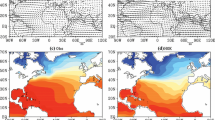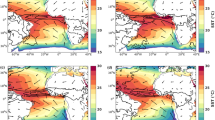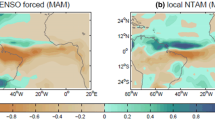Abstract
Using multiple reanalysis datasets and model simulations, we begin in this study by isolating the tropical Atlantic Ocean (TAO) sea surface temperature (SST) signals that are independent from ENSO, and then investigate their influences on the northern winter stratosphere. It is revealed that TAO SST forcing does indeed have significant effects on the northern winter stratosphere, but these effects vary from early to late winter in a way that explains the overall insignificant effect when the seasonal average is considered. The stratospheric polar vortex is anomalously weaker/warmer in November–December, stronger/colder in January–March, and weaker/warmer again in April–May during warm TAO years. The varying impacts of the TAO forcing on the extratropical stratosphere are related to a three-stage response of the extratropical troposphere to the TAO forcing during cold season. The tropospheric circulation exhibits a negative North Atlantic Oscillation–like response during early winter, an eastward propagating Rossby wave pattern in mid-to-late winter, and a meridional dipole over North America in spring. Associated with this is varying planetary wave activity in the stratosphere, manifested as an increase in early winter, a decrease in mid-to-late winter, and an increase again in spring. The varying modulation of stratospheric circulation by TAO forcing is consistently confirmed in three reanalysis datasets, and model simulations (fully coupled model and its component AGCM). The exception to the robustness of this verification is that the circumpolar wind response in the fully coupled model is relatively weaker, and that in its component AGCM appears a month later than observed.











Similar content being viewed by others
References
Alexander MA, Blade I, Newman M, Lanzante JR, Lau NC, Scott JD (2002) The atmospheric bridge: the influence of ENSO teleconnections on air-sea interaction over the global oceans. J Clim 15(16):2205–2231
Ashok K, Behera SK, Rao SA, Weng H, Yamagata T (2007) El Niño Modoki and its possible teleconnection. J Geophys Res 112:C11007. https://doi.org/10.1029/2006jc003798
Baldwin MP, O’Sullivan D (1995) Stratospheric effects of ENSO-related tropospheric circulation anomalies. J Clim 8(4):649–667
Calvo N, Garcia-Herrera R, Garcia RR (2008) The ENSO signal in the stratosphere. Ann N Y Acad Sci 114616–114631. https://doi.org/10.1196/annals.1446.008
Calvo N, Garcia RR, Randel WJ, Marsh DR (2010) Dynamical mechanism for the increase in tropical upwelling in the lowermost tropical stratosphere during warm ENSO events. J Atmos Sci 67(7):2331–2340. https://doi.org/10.1175/2010jas3433.1
Camp CD, Tung KK (2007) The influence of the solar cycle and QBO on the late-winter stratospheric polar vortex. J Atmos Sci 64(4):1267–1283. https://doi.org/10.1175/jas3883.1
Chang P, Saravanan R, Ji L, Hegerl GC (2000) The effect of local sea surface temperatures on atmospheric circulation over the tropical Atlantic sector. J Clim 13(13):2195–2216
Cohen J, Jones J (2011) Tropospheric precursors and stratospheric warmings. J Clim 24(24):6562–6572. https://doi.org/10.1175/2011jcli4160.1
Czaja A, Frankignoul C (2002) Observed impact of Atlantic SST anomalies on the North Atlantic oscillation. J Clim 15(6):606–623
Danabasoglu G, Bates SC, Briegleb BP, Jayne SR, Jochum M, Large WG, Peacock S, Yeager SG (2012) The CCSM4 Ocean Component. J Clim 25(5):1361–1389. https://doi.org/10.1175/jcli-d-11-00091.1
Dee DP, Uppala SM, Simmons AJ et al (2011) The ERA-Interim reanalysis: configuration and performance of the data assimilation system. Quart J Roy Meteor Soc 137(656):553–597. https://doi.org/10.1002/qj.828
Drévillon M, Cassou C, Terray L (2003) Model study of the North Atlantic region atmospheric response to autumn tropical Atlantic sea-surface-temperature anomalies. Quart J Roy Meteor Soc 129(593):2591–2611. https://doi.org/10.1256/qj.02.17
Ebita A, Kobayashi S, Ota Y, Moriya M, Kumabe R, Onogi K, Harada Y, Yasui S, Miyaoka K, Takahashi K, Kamahori H, Kobayashi C, Endo H, Soma M, Oikawa Y, Ishimizu T (2011) The Japanese 55-year reanalysis “JRA-55”: An interim report. SOLA 7:149–152. https://doi.org/10.2151/sola.2011-038
Eyring V, Waugh DW, Bodeker GE et al (2007) Multimodel projections of stratospheric ozone in the 21st century. J Geophys Res 112:D16303. https://doi.org/10.1029/2006jd008332
Frankignoul C, Kestenare E (2002) The surface heat flux feedback. Part I: estimates from observations in the Atlantic and the North Pacific. Climate Dyn 19(8):633–647
Garcia RR, Marsh DR, Kinnison DE, Boville BA, Sassi F (2007) Simulation of secular trends in the middle atmosphere, 1950–2003. J Geophys Res 112:D09301. https://doi.org/10.1029/2006jd007485
Garfinkel CI, Hartmann DL (2007) Effects of the El Niño–Southern Oscillation and the Quasi-Biennial Oscillation on polar temperatures in the stratosphere. J Geophys Res 112:D19112. https://doi.org/10.1029/2007jd008481
Garfinkel CI, Hurwitz MM, Waugh DW, Butler AH (2012a) Are the teleconnections of Central Pacific and Eastern Pacific El Niño distinct in boreal wintertime? Clim Dyn 41(7–8):1835–1852. https://doi.org/10.1007/s00382-012-1570-2
Garfinkel CI, Shaw TA, Hartmann DL, Waugh DW (2012b) Does the Holton–Tan mechanism explain how the Quasi-Biennial Oscillation modulates the Arctic polar vortex? J Atmos Sci 69(5):1713–1733. https://doi.org/10.1175/jas-d-11-0209.1
Gastineau G, D’Andrea F, Frankignoul C (2013) Atmospheric response to the North Atlantic Ocean variability on seasonal to decadal time scales. Clim Dyn 40(9–10):2311–2330. https://doi.org/10.1007/s00382-012-1333-0
Gent PR, Danabasoglu G, Donner LJ, Holland MM, Hunke EC, Jayne SR, Lawrence DM, Neale RB, Rasch PJ, Vertenstein M, Worley PH, Yang ZL, Zhang MH (2011) The community climate system model version 4. J Clim 24(19):4973–4991. https://doi.org/10.1175/2011jcli4083.1
Haarsma RJ, Hazeleger W (2007) Extratropical atmospheric response to equatorial Atlantic cold tongue anomalies. J Clim 20(10):2076–2091. https://doi.org/10.1175/jcli4130.1
Hegyi BM, Deng Y (2011) A dynamical fingerprint of tropical Pacific sea surface temperatures on the decadal-scale variability of cool-season Arctic precipitation. J Geophys Res 116:D20121. https://doi.org/10.1029/2011jd016001
Hegyi BM, Deng Y, Black RX, Zhou RJ (2014) Initial transient response of the winter polar stratospheric vortex to idealized equatorial Pacific sea surface temperature anomalies in the NCAR WACCM. J Clim 27(7):2699–2713. https://doi.org/10.1175/icli-d-13-00289.1
Hoerling MP, Kumar A, Zhong M (1997) El Niño, La Niña, and the nonlinearity of their teleconnections. J Clim 10:1769–1786. https://doi.org/10.1175/1520-0442(1997)010<1769:enolna>2.0.co;2
Holland MM, Bailey DA, Briegleb BP, Light B, Hunke E (2012) Improved sea ice shortwave radiation physics in CCSM4: the impact of melt ponds and aerosols on arctic sea ice. J Clim 25(5):1413–1430. https://doi.org/10.1175/jcli-d-11-00078.1
Holton JR, Tan HC (1980) The influence of the equatorial Quasi-Biennial Oscillation on the global circulation at 50mb. J Atmos Sci 37(10):2200–2208. https://doi.org/10.1175/1520-0469(1980)037<2200:tioteq>2.0.co;2
Hu D, Tian W, Xie F, Shu J, Dhomse S (2014) Effects of meridional sea surface temperature changes on stratospheric temperature and circulation. Adv Atmos Sci 31(4):888–900. https://doi.org/10.1007/s00376-013-3152-6
Hu J, Li T, Xu H, Yang S (2017) Lessened response of boreal winter stratospheric polar vortex to El Niño in recent decades. Clim Dyn 49(1–2):263–278. https://doi.org/10.1007/s00382-016-3340-z
Ishii M, Shouji A, Sugimoto S, Matsumoto T (2005) Objective analyses of sea-surface temperature and marine meteorological variables for the 20th century using ICOADS and the Kobe Collection. Int J Climatol 25:865–879
Kalnay E, Kanamitsu M, Kistler R et al (1996) The NCEP/NCAR 40-year reanalysis project. Bull Am Meteor Soc 77(3):437–471
Kanamitsu M, Ebisuzaki W, Woollen J, Yang SK, Hnilo JJ, Fiorino M, Potter GL (2002) NCEP-DOE AMIP-II reanalysis (R-2). Bull Am Meteor Soc 83(11):1631–1643. https://doi.org/10.1175/bams-83-11-1631
Klein SA, Soden BJ, Lau NC (1999) Remote sea surface temperature variations during ENSO: evidence for a tropical atmospheric bridge. J Clim 12:917–932. https://doi.org/10.1175/1520-0442(1999)012<0917:rsstvd>2.0.co;2
Kobayashi S, Ota Y, Harada Y, Ebita A, Moriya M, Onoda H, Onogi K, Kamahori H, Kobayashi C, Endo H, Miyaoka K, Takahashi K (2015) The JRA-55 reanalysis: General specifications and basic characteristics. J Meteor Soc Japan 93(1):5–48. https://doi.org/10.2151/jmsj.2015-001
Kodera K, Kuroda Y (2002) Dynamical response to the solar cycle. J Geophys Res 107(D24):4749. https://doi.org/10.1029/2002jd002224
Li SL, Robinson WA, Hoerling MP, Weickmann KM (2007) Dynamics of the extratropical response to a tropical Atlantic SST anomaly. J Clim 20(3):560–574. https://doi.org/10.1175/jcli4014.1
Manzini E, Giorgetta MA, Esch M, Kornblueh L, Roeckner E (2006) The influence of sea surface temperatures on the northern winter stratosphere: Ensemble simulations with the MAECHAM5 model. J Clim 19(16):3863–3881. https://doi.org/10.1175/jcli3826.1
Marsh DR, Mills MJ, Kinnison DE, Lamarque JF, Calvo N, Polvani LM (2013) Climate change from 1850 to 2005 simulated in CESM1(WACCM). J Clim 26(19):7372–7391. https://doi.org/10.1175/jcli-d-12-00558.1
Matthes K, Kuroda Y, Kodera K, Langematz U (2006) Transfer of the solar signal from the stratosphere to the troposphere: Northern winter. J Geophys Res 111(D6):1003–1019. https://doi.org/10.1029/2005jd006283
Peng S, Robinson WA, Li S, Hoerling MP (2005) Tropical Atlantic SST forcing of coupled North Atlantic seasonal responses. J Clim 18:480–496
Plumb RA (1985) On the three-dimensional propagation of stationary waves. J Atmos Sci 42(3):217–229
Rao J, Ren RC (2016a) A decomposition of ENSO’s impacts on the northern winter stratosphere: competing effect of SST forcing in the tropical. Indian Ocean Clim Dyn 46:3689–3707. https://doi.org/10.1007/s00382-015-2797-5
Rao J, Ren RC (2016b) Asymmetry and nonlinearity of the influence of ENSO on the northern winter stratosphere: 1. Observations. J Geophys Res Atmos 121:9000–9016. https://doi.org/10.1002/2015jd024520
Rao J, Ren RC (2016c) Asymmetry and nonlinearity of the influence of ENSO on the northern winter stratosphere: 2. Model study with WACCM. J Geophys Res Atmos 121:9017–9032. https://doi.org/10.1002/2015jd024521
Rao J, Ren RC (2017) Parallel comparison of the 1982/83, 1997/98, and 2015/16 super El Niños and their effects on the extratropical stratosphere. Adv Atmos Sci 34:1121–1133. https://doi.org/10.1007/s00376-017-6260-x
Rayner NA, Parker DE, Horton EB, Folland CK, Alexander LV, Rowell DP, Kent EC, Kaplan A (2003) Global analyses of sea surface temperature, sea ice, and night marine air temperature since the late nineteenth century. J Geophys Res 108(D14):4407. https://doi.org/10.1029/2002jd002670
Ren RC, Cai M, Xiang C, Wu G (2012) Observational evidence of the delayed response of stratospheric polar vortex variability to ENSO SST anomalies. Clim Dyn 38(7–8):1345–1358. https://doi.org/10.1007/s00382-011-1137-7
Ren RC, Rao J, Wu GX, Cai M (2017) Tracking the delayed response of the northern winter stratosphere to ENSO using multi reanalyses and model simulations. Clim Dyn 48:2859–2879. https://doi.org/10.1007/s00382-016-3238-9
Richter JH, Sassi F, Garcia RR (2010) Toward a physically based gravity wave source parameterization in a general circulation model. J Atmos Sci 67(1):136–156. https://doi.org/10.1175/2009jas3112.1
Rogers JC (1981) The North Pacific Oscillation. Int J Climatol 1(1):39–57
Sassi F, Kinnison D, Boville BA, Garcia RR, Roble R (2004) Effect of El Niño-Southern Oscillation on the dynamical, thermal, and chemical structure of the middle atmosphere. J Geophys Res 109:D17108. https://doi.org/10.1029/2003jd004434
Smith KL, Kushner PJ (2012) Linear interference and the initiation of extratropical stratosphere-troposphere interactions. J Geophys Res 117:D13107. https://doi.org/10.1029/2012jd017587
Sutton RT, Hodson DLR (2007) Climate response to basin-scale warming and cooling of the North Atlantic Ocean. J Clim 20(5):891–907. https://doi.org/10.1175/jcli4038.1
Wallace JM, Panetta RL, Estberg J (1993) Representation of the equatorial stratospheric Quasi-Biennial Oscillation in EOF phase space. J Atmos Sci 50:1751–1762
Wang C, Lee S-K, Enfield DB (2008) Climate response to anomalously large and small Atlantic warm pools during the summer. J Clim 21(11):2437–2450. https://doi.org/10.1175/2007jcli2029.1
Wei K, Chen W, Huang R (2007) Association of tropical Pacific sea surface temperatures with the stratospheric Holton-Tan Oscillation in the Northern Hemisphere winter. Geophys Res Lett 34:L16814. https://doi.org/10.1029/2007gl030478
White IP, Lu H, Mitchell NJ, Phillips T (2015) Dynamical response to the QBO in the northern winter stratosphere: Signatures in wave forcing and eddy fluxes of potential vorticity. J Atmos Sci 72(12):4487–4507. https://doi.org/10.1175/jas-d-14-0358.1
White IP, Lu H, Mitchell NJ (2016) Seasonal evolution of the QBO-induced wave forcing and circulation anomalies in the northern winter stratosphere. J Geophys Res Atmos 121(18):10411–10431. https://doi.org/10.1002/2015jd024507
Wu B, Li T, Zhou TJ (2010) Asymmetry of atmospheric circulation anomalies over the western North Pacific between El Niño and La Niña. J Clim 23:4807–4822. https://doi.org/10.1175/2010jcli3222.1
Xie F, Li J, Tian W, Feng J, Huo Y (2012) Signals of El Niño Modoki in the tropical tropopause layer and stratosphere. Atmos Chem Phys 12(11):5259–5273. https://doi.org/10.5194/acp-12-5259-2012
Yang S, Li T, Hu J, Shen X (2017) Decadal variation of the impact of La Niña on the winter Arctic stratosphere. Adv Atmos Sci 34(5):679–684. https://doi.org/10.1007/s00376-016-6184-x
Zebiak SE (1993) Air–Sea interaction in the equatorial Atlantic region. J Clim 6(8):1567–1586
Zhou X, Li J, Xie F, Ding R, Li Y, Zhao S, Zhang J, Li Y (2017) The effects of the Indo-Pacific warm pool on the stratosphere. Clim Dyn. https://doi.org/10.1007/s00382-017-3584-2
Acknowledgements
This work was jointly supported by grants from the National Science Foundation of China (41705024, 41575041), the Startup Foundation for Introducing Talent of NUIST (2016r060), the National Key Research and Development Program of China (2016YFA0602104), and the Priority Academic Program Development of Jiangsu Higher Education Institutions (PAPD). We acknowledge the JMA, NOAA, and ECMWF for providing the reanalysis data.
Author information
Authors and Affiliations
Corresponding author
Additional information
A follow-up paper to “A decomposition of ENSO’s impacts on the northern winter stratosphere: competing effect of SST forcing in the tropical Indian Ocean” in Climate Dynamics, 2016, https://doi.org/10.1007/s00382-015-2797-5.
Electronic supplementary material
Below is the link to the electronic supplementary material.
Rights and permissions
About this article
Cite this article
Rao, J., Ren, R. Varying stratospheric responses to tropical Atlantic SST forcing from early to late winter. Clim Dyn 51, 2079–2096 (2018). https://doi.org/10.1007/s00382-017-3998-x
Received:
Accepted:
Published:
Issue Date:
DOI: https://doi.org/10.1007/s00382-017-3998-x




